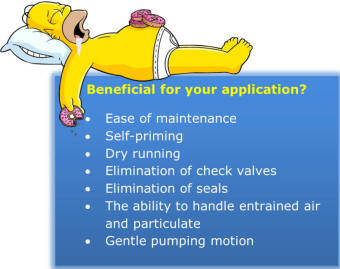Industrial Applications for Peristaltic Pumps
Our previous article “Characteristics
of Industrial Peristaltic Pumps” described modern hose pump
design. This article describes the multitude of applications benefiting
from the unique and sealless design of peristaltic pumps.
Peristaltic pumps are used in lieu of air-operated diaphragm (AOD),
progressing cavity (PC), gear and rotary lobe style pumps for the following
types of applications:
Shear and emulsion sensitive fluids
Slurries, sludges and viscous fluids
Contamination
Suction lift, self-priming and dry running
 The most common denominator for all peristaltic pump applications is
reduced operational costs due to a combination of less maintenance (parts &
labor), increased reliability and improved product quality. Other pumps
leak, clog and corrode due to designs having seals, valves, diaphragms and
rotors.
The most common denominator for all peristaltic pump applications is
reduced operational costs due to a combination of less maintenance (parts &
labor), increased reliability and improved product quality. Other pumps
leak, clog and corrode due to designs having seals, valves, diaphragms and
rotors.
Following are examples of applications within the chemical processing
industry (CPI), water and waste treatment (WWT) and food manufacturing
industries which highlight the advantages of the peristaltic hose pump design.
 It is easy being “green”!
It is easy being “green”!
One such application is the transfer of paint and dye. These materials are often shear sensitive and viscous, so the gentle pumping action involving only the compression of a hose with smooth interior finish supports efficient transfer with the suction lift and discharge pressure typically required.
The reversible nature of peristaltic hose pumps enables transfer to and from an applicator, reducing the number of pumps required.
 Water and waste treatment (WWT) applications involve dispensing chemicals
and moving gritty sludge.
Water and waste treatment (WWT) applications involve dispensing chemicals
and moving gritty sludge.
Reliably dosing chemicals to purify, control foaming and promote flocculation benefit from the sealless peristaltic hose pump design. In addition to being hazardous to personnel and the environment, some of these chemicals are shear sensitive, losing their flocculation efficiency when over-agitated.
Slurries, sludges and viscous fluids
Contamination
Suction lift, self-priming and dry running
 The most common denominator for all peristaltic pump applications is
reduced operational costs due to a combination of less maintenance (parts &
labor), increased reliability and improved product quality. Other pumps
leak, clog and corrode due to designs having seals, valves, diaphragms and
rotors.
The most common denominator for all peristaltic pump applications is
reduced operational costs due to a combination of less maintenance (parts &
labor), increased reliability and improved product quality. Other pumps
leak, clog and corrode due to designs having seals, valves, diaphragms and
rotors. It is easy being “green”!
It is easy being “green”!
One such application is the transfer of paint and dye. These materials are often shear sensitive and viscous, so the gentle pumping action involving only the compression of a hose with smooth interior finish supports efficient transfer with the suction lift and discharge pressure typically required.
The reversible nature of peristaltic hose pumps enables transfer to and from an applicator, reducing the number of pumps required.
 Water and waste treatment (WWT) applications involve dispensing chemicals
and moving gritty sludge.
Water and waste treatment (WWT) applications involve dispensing chemicals
and moving gritty sludge. Reliably dosing chemicals to purify, control foaming and promote flocculation benefit from the sealless peristaltic hose pump design. In addition to being hazardous to personnel and the environment, some of these chemicals are shear sensitive, losing their flocculation efficiency when over-agitated.
| Typical WWT Chemicals |
|
| Chemical |
Purpose |
| Sodium Hypochlorite |
Disinfection & odor removal |
| Aluminum Sulfate Sodium Aluminate |
Coagulation (flocculation) of suspended impurities |
| Aluminum Hydroxide |
Removal of excess fluoride |
| Potassium Hydroxide |
pH adjustment |
 Food & Beverage Manufacturing
Food & Beverage ManufacturingMmm…Donuts!
It is desirable to keep some ingredients whole, such as nuts and fruit pieces found in fruitcake dough.
Likewise, cream, milk and yogurt are also shear sensitive, benefitting from the gentle pumping action of a peristaltic hose pump.

Ingredients such as vitamins have a tendency towards crystallization and
are abrasive in nature. Since the rotary pumping mechanism of a
peristaltic hose pump is external to the material pumped, there is less
contamination and leakage potential. Dry cavity roller style peristaltic hose
pumps have a light food-grade grease applied externally to the hose whereas the
shoe style peristaltic pumps require glycerin or glycol reservoir for hose
lubrication.
 A “MUST” have Pump!
A “MUST” have Pump!
Solving Problems
Visit our website and use our peristaltic pump inquiry form pictured below which prompts you for all of the required information for us to provide a detailed proposal for your specific application.
 A “MUST” have Pump!
A “MUST” have Pump!Solving Problems
Visit our website and use our peristaltic pump inquiry form pictured below which prompts you for all of the required information for us to provide a detailed proposal for your specific application.





